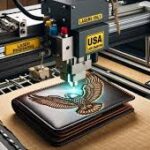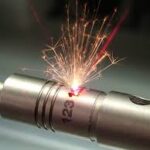What is Laser Etching? is a specialized process in which a laser beam alters the surface of a material to create permanent marks. It is a subset of laser engraving but differs slightly in technique and application. Laser etching involves melting the material to create a raised or indented mark, unlike engraving, which removes material to create a deeper cut.
This precise, efficient, and non-contact process is widely used for creating intricate designs, text, and functional markings on various materials.

How Does Work?
works by focusing a high-intensity laser beam onto a specific area of the material. The heat generated by the laser causes the surface of the material to melt and expand, creating a permanent mark. The process does not penetrate deeply into the material, making it suitable for delicate and thin surfaces.
Key components of the system:
Laser Source: Generates the laser beam.
Controller: Directs the laser beam to the specific points of the material.
Marking Surface: The material being etched.
Materials Suitable
can be performed on a variety of materials, including:
Metals: Stainless steel, aluminum, titanium, and brass.
Plastics: ABS, polycarbonate, and acrylic.
Glass: Bottles, mirrors, and decorative items.
Ceramics: Tiles, plates, and mugs.
Coated Surfaces: Anodized aluminum, painted metals.

Applications
Laser etching is highly versatile and used in various industries. Some of its common applications include:
- Product Branding
Manufacturers use laser etching to add logos, brand names, and serial numbers to their products. It is especially common in electronics and automotive industries. - Jewelry Customization
Laser etching allows for the creation of intricate and personalized designs on rings, bracelets, and pendants. - Barcoding and QR Codes
Industries use laser etching to mark barcodes, QR codes, and identification numbers on products for tracking and quality assurance. - Medical Instruments
Etched markings on medical tools and devices ensure traceability and compliance with industry standards. - Decorative Art
Artists use laser etching to create detailed and intricate patterns on glass, wood, and metal objects.
Advantages
High Precision: Laser etching allows for intricate and detailed markings with excellent clarity.
Non-Contact Process: There is no physical contact with the material, reducing the risk of damage.
Permanent Markings: The marks are durable, resistant to wear, and unaffected by heat or chemicals.
Eco-Friendly: Laser etching is a clean process that generates minimal waste.
Wide Material Compatibility: Suitable for metals, plastics, glass, ceramics, and more.
Cost-Effective: Requires minimal maintenance and has a long operational lifespan.
How to Choose a Laser Etching Machine
When choosing a laser etching machine, consider the following factors:
Material Type: Determine which material you will etch most frequently.
Power Requirement: Higher power for metals; lower power for delicate materials like glass.
Work Area Size: Ensure the machine can handle the size of your projects.
Software Compatibility: Look for machines compatible with design software like AutoCAD and CorelDRAW.
Conclusion
Laser etching is a modern and efficient method for creating permanent and precise markings on a wide variety of materials. Its advantages, such as durability, precision, and eco-friendliness, make it an ideal choice for industries ranging from manufacturing to art. Whether for functional markings or decorative purposes, laser etching is a reliable and versatile technology that continues to evolve and find new applications.




